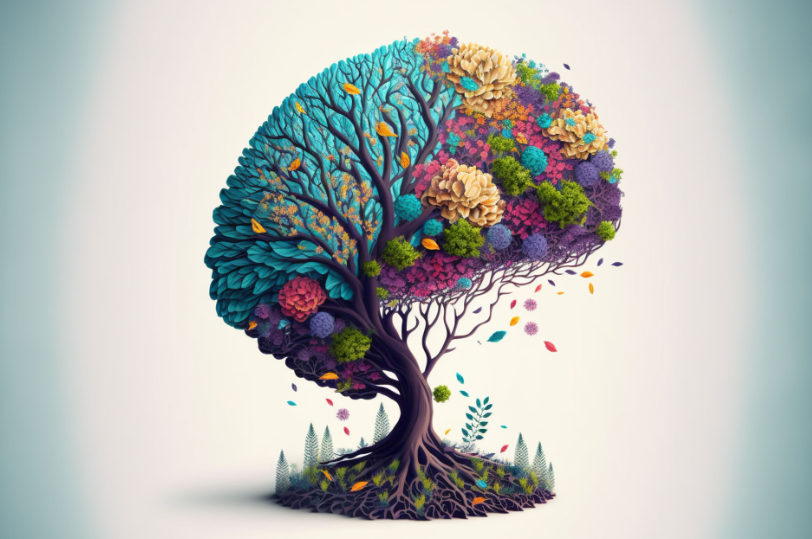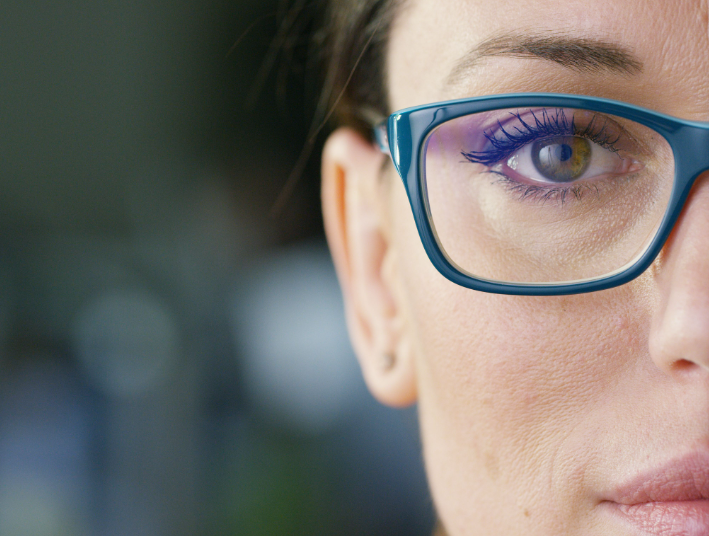by Deborah Zelinsky, O.D.
Pregnant women subjected to domestic violence – both physical and psychological – are more likely to give birth to infants with abnormalities in eye-hand and eye-ear coordination, have future difficulties in learning, and problems related to mood and behavior regulation. These children often are given labels on the autism spectrum, including attention-deficit (with hyperactivity) disorder (AD(H)D) and pervasive developmental disorder (PDD).
Women in domestic violence situations are under chronic stress and anxiety, and scientific evidence shows that this stress can significantly impact development of the fetal brain and central nervous system, ultimately retarding maturation of the newborn’s visual processing capabilities. Ongoing stress, of course, affects the mother as well. Beyond the physical effects of violence, such as traumatic brain injury and all its related symptoms, living in constant fear and anxiety can lead to neuropsychiatric disorders, depression, and post-traumatic stress disorder (PTSD). Physical violence to a pregnant mother also can startle the unborn baby in a way analogous to a person being rear-ended in a car accident. Out of nowhere, there is a sudden, jolting shock to the brain.
The Mind-Eye Institute is internationally known for its work in stimulating, modifying, and regulating patients’ visual processing. The term “visual processing” refers to the brain’s almost instantaneous ability, consciously and subconsciously, to take in external sensory signals (from eyesight, hearing, smell, taste, and touch), combine them with a person’s internal sensory signals (such as head position and muscle tension), and process the information, allowing a person to react and respond to his or her environment.
When functioning normally, visual processing enables people to understand and interact appropriately to the world around them. When brain circuitry is disrupted due to injury or neurological disorders such as PTSD, people become confused about their surrounding environment and exhibit inappropriate reactions and responses to movement, sounds, and light For example, someone under stress might catch something moving out of the corner of the eye and visualize a threat, initiating a cascade of body reactions and thoughts. The same movement seen by someone not under stress would either be ignored or investigated more closely to determine the innocuous source. That person’s mind would be in “logic mode” rather than “emotional mode,” and their body would remain calm.
Visual processing skills are essential to all aspects of learning, but these are the very skills that can be affected when the fetus is exposed to high levels of environmental stressors.Stressors after birth can hypersensitize peripheral eyesight, putting a newborn into fight-or-flight mode. Stressful factors also can prevent the natural decline of a child’s protective mechanisms, such as the Moro (protective) reflex.The lack of integration of those primitive reflexes can often compromise needed development of postural reflexes that, subconsciously, govern posture, body alignment, head control, and eye-hand coordination.
As an infant reaches several months of age, both its binocular visual system the peripheral eyesight of each eye that starts to synchronize – and its posture should be noticeably developing. The child learns to sit and hold up its head.
However, studies increasingly indicate that a mother’s overproduction of stress chemicals causes higher levels of those chemicals to cross the placental barrier. The result may be a slowing or inhibition of the infant’s reflex-maturation process after birth.
The vestibular system is the only system fully developed at birth. Hypersensitivity in that system can affect such factors as a child’s balance and eye-hand coordination. Visual-perceptual and eye-ear disorders can be manifested by abnormal eye movements, and stress can induce sensitivity to light and sound, as well as slowed reactions to moving objects. The Mind-Eye team is able to test such reflexes in babies as early as four months of age.
All of these factors can, and do, impact a child’s later ability to learn and to interact normally with others. The Mind-Eye Institute combats symptoms of brain injury and neurological disorders and helps develop, or re-establish,patients’ visual processing capabilities by using therapeutic eyeglasses and other advanced mind-eye techniques. “Brain” glasses bend light in different ways across the retina, which is composed of brain tissue and is part of the central nervous system.
“Brain” glasses are not about achieving 20/20 clarity. They are designed to improve patient comfort by rewiring dysfunctions in peripheral retina signals. The intent is to resynchronize brain circuitry between motor and sensory systems in order to improve a patient’s overall visual processing. The motor and sensory circuitries are meshed with other systems due to interactions of the retina directly with brain stem and limbic functions. In babies, though, usually simple activities are effective for altering development, without the need for lenses.
Light is the way in which the retina communicates with the brain, and the brain responds. The light is first converted into chemical signals, which then trigger electrical signals that propagate through nerves. In fact, the eye plays a critical role in routing information through multiple pathways to the brain’s cortex. Variance in light signals can create new brain signaling pathways that are uncorrupted by injury or disease, or rebuild or, more often, circumvent damaged ones, thereby enhancing a patient’s spatial awareness and perception. “Of course, in the brain, signaling pathways are two-way streets, and the retina receives signals from the body also.”
In one of the latest studies, appearing in a 2019 issue of the Proceedings of the National Academy of Sciences, researchers state that “pregnant women [who are considered] in the top 15% for prenatal anxiety and depression have offspring with an estimated two-fold increased risk for a mental disorder (namely, attention deficit hyperactivity disorder or anxiety), and this effect extends from childhood through adolescence.” These same authors also link high fetal stress with lower intelligence scores, language development delays, and autistic traits.
Optometrists are in position to be at the forefront of developing or re-establishing normal brain function by using eyeglasses and/or visual-learning activities to alter patients’ nervous systems. We are in an era of neuroscience that is providing us much more knowledge about the interdependence between mind and body. Those continual scientific discoveries are enabling optometrists and other professionals to assess and address symptoms related to brain injury, learning difficulties, and other neurological disorders.
The suffering caused by domestic violence during pregnancy does not have to alter a child’s future.”
Deborah Zelinsky, O.D., is a Chicago optometrist who founded the Mind-Eye Connection, now known as the Mind-Eye Institute. She is a clinician and brain researcher with a mission of building better brains by changing the concept of eye examinations into brain evaluations. For the past three decades, her research has been dedicated to interactions between the eyes and ears, bringing 21st-Century research into optometry, thus bridging the gap between neuroscience and eye care.












![We start TONIGHT —
join my virtual writing group for a rare chance to work directly with me while completing your writing project
Are you finding it hard to carve out time for writing and creativity?
Life gets busy, and it can be challenging to prioritize your creative projects—whether you’re working on:
a book,
blog posts,
social media content,
or even crafting an email series or a new product for your business.
That’s why I’ve created our Virtual Writing Group—a dedicated space where you can focus on your writing, whatever form it takes, and connect with a community of like-minded creatives.
JOIN NOW: https://creatingwellnessfromwithin.com/writinggroup/
Why Join?
- Monthly Writing Sessions: We meet on the first Wednesday of each month from 6-8 PM CST. This is your time to sit down, focus, and make progress on your writing projects.
- Creative Community: No matter what you’re writing, you’ll find support and inspiration from fellow writers who understand the challenges and rewards of the creative process.
- Accountability & Connection: Share your goals, overcome writer’s block, and enjoy the camaraderie of working alongside others on their own creative journeys.
- Whether you’re crafting a novel, drafting blog posts, planning social media content, or developing a product or email series for your business, this group is here to help you stay on track and make your creative dreams a reality.
If this sounds like the support you need, I’d love for you to join us! For just $108 a year—about the cost of a fancy coffee drink each month—you’ll have a year of inspiration, connection, and dedicated writing time.
Ready to prioritize your creativity? Click [here] to secure your spot in our Virtual Writing Group. We start September 4th!!
I can’t wait to see what you create! We start TONIGHT —
join my virtual writing group for a rare chance to work directly with me while completing your writing project
Are you finding it hard to carve out time for writing and creativity?
Life gets busy, and it can be challenging to prioritize your creative projects—whether you’re working on:
a book,
blog posts,
social media content,
or even crafting an email series or a new product for your business.
That’s why I’ve created our Virtual Writing Group—a dedicated space where you can focus on your writing, whatever form it takes, and connect with a community of like-minded creatives.
JOIN NOW: https://creatingwellnessfromwithin.com/writinggroup/
Why Join?
- Monthly Writing Sessions: We meet on the first Wednesday of each month from 6-8 PM CST. This is your time to sit down, focus, and make progress on your writing projects.
- Creative Community: No matter what you’re writing, you’ll find support and inspiration from fellow writers who understand the challenges and rewards of the creative process.
- Accountability & Connection: Share your goals, overcome writer’s block, and enjoy the camaraderie of working alongside others on their own creative journeys.
- Whether you’re crafting a novel, drafting blog posts, planning social media content, or developing a product or email series for your business, this group is here to help you stay on track and make your creative dreams a reality.
If this sounds like the support you need, I’d love for you to join us! For just $108 a year—about the cost of a fancy coffee drink each month—you’ll have a year of inspiration, connection, and dedicated writing time.
Ready to prioritize your creativity? Click [here] to secure your spot in our Virtual Writing Group. We start September 4th!!
I can’t wait to see what you create!](https://scontent-atl3-2.cdninstagram.com/v/t51.29350-15/458341018_483345868037283_1467344792046745902_n.jpg?_nc_cat=111&ccb=1-7&_nc_sid=18de74&_nc_ohc=AVat1r0LeYAQ7kNvgH2i36q&_nc_zt=23&_nc_ht=scontent-atl3-2.cdninstagram.com&edm=ANo9K5cEAAAA&_nc_gid=Ak_pXu5bmWR5Iwx8b92pBhJ&oh=00_AYBqBJ598W82U1S0UonuTC6yXjYQpxnfoEk7Ib-wW8Jh7A&oe=671C899F)







